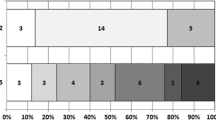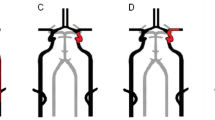Abstract
Purpose
Intracranial carotid artery occlusion represents an underinvestigated cause of acute ischemic stroke as well as an indication for mechanical thrombectomy. We investigated baseline and procedural characteristics, outcomes and predictors of outcome in patients with acute ischemic stroke secondary to intracranial carotid artery occlusion.
Methods
A retrospective analysis of the Italian Registry of Endovascular Treatment in Acute Stroke was performed. Patients with intracranial carotid artery occlusion (infraclinoid and supraclinoid) with or without cervical artery occlusion but with patent intracranial arteries were included. The 3‑month functional independence, mortality, successful reperfusion and symptomatic intracranial hemorrhage were evaluated.
Results
Intracranial carotid artery occlusion with patent intracranial arteries was diagnosed in 387 out of 4940 (7.8%) patients. The median age was 74 years and median baseline National Institute of Health Stroke Scale (NIHSS) was 18. Functional independence was achieved in 130 (34%) patients, successful reperfusion in 289 (75%) and symptomatic intracranial hemorrhage in 33 (9%), whereas mortality occurred in 111 (29%) patients. In univariate analysis functional independence was associated with lower age, lower NIHSS at presentation, higher rate of successful reperfusion and lower rate of symptomatic intracranial hemorrhage. Multivariable regression analysis found age (odds ratio, OR:1.03; P = 0.006), NIHSS at presentation (OR: 1.07; P < 0.001), diabetes (OR: 2.60; P = 0.002), successful reperfusion (OR:0.20; P < 0.001) and symptomatic intracranial hemorrhage (OR: 4.17; P < 0.001) as the best independent predictors of outcome.
Conclusion
Our study showed a not negligible rate of intracranial carotid artery occlusion with patent intracranial arteries, presenting mostly as severe stroke, with an acceptable rate of 3‑month functional independence. Age, NIHSS at presentation and successful reperfusion were the best independent predictors of outcome.
Similar content being viewed by others
References
Campbell BC, Mitchell PJ, Kleinig TJ, Dewey HM, Churilov L, Yassi N, Yan B, Dowling RJ, Parsons MW, Oxley TJ, Wu TY, Brooks M, Simpson MA, Miteff F, Levi CR, Krause M, Harrington TJ, Faulder KC, Steinfort BS, Priglinger M, Ang T, Scroop R, Barber PA, McGuinness B, Wijeratne T, Phan TG, Chong W, Chandra RV, Bladin CF, Badve M, Rice H, de Villiers L, Ma H, Desmond PM, Donnan GA, Davis SM; EXTEND-IA Investigators. Endovascular therapy for ischemic stroke with perfusion-imaging selection. N Engl J Med. 2015;372:1009-18.
Saver JL, Goyal M, Bonafe A, Diener HC, Levy EI, Pereira VM, Albers GW, Cognard C, Cohen DJ, Hacke W, Jansen O, Jovin TG, Mattle HP, Nogueira RG, Siddiqui AH, Yavagal DR, Baxter BW, Devlin TG, Lopes DK, Reddy VK, du Mesnil de Rochemont R, Singer OC, Jahan R; SWIFT PRIME Investigators. Stent-retriever thrombectomy after intravenous t-PA vs. t-PA alone in stroke. N Engl J Med. 2015;372:2285–95.
Berkhemer OA, Fransen PS, Beumer D, van den Berg LA, Lingsma HF, Yoo AJ, Schonewille WJ, Vos JA, Nederkoorn PJ, Wermer MJ, van Walderveen MA, Staals J, Hofmeijer J, van Oostayen JA, Lycklama à Nijeholt GJ, Boiten J, Brouwer PA, Emmer BJ, de Bruijn SF, van Dijk LC, Kappelle LJ, Lo RH, van Dijk EJ, de Vries J, de Kort PL, van Rooij WJ, van den Berg JS, van Hasselt BA, Aerden LA, Dallinga RJ, Visser MC, Bot JC, Vroomen PC, Eshghi O, Schreuder TH, Heijboer RJ, Keizer K, Tielbeek AV, den Hertog HM, Gerrits DG, van den Berg-Vos RM, Karas GB, Steyerberg EW, Flach HZ, Marquering HA, Sprengers ME, Jenniskens SF, Beenen LF, van den Berg R, Koudstaal PJ, van Zwam WH, Roos YB, van der Lugt A, van Oostenbrugge RJ, Majoie CB, Dippel DW; MR CLEAN Investigators. A randomized trial of intraarterial treatment for acute ischemic stroke. N Engl J Med. 2015;372:11–20. Erratum in: N Engl J Med. 2015;372:394.
Jovin TG, Chamorro A, Cobo E, de Miquel MA, Molina CA, Rovira A, San Román L, Serena J, Abilleira S, Ribó M, Millán M, Urra X, Cardona P, López-Cancio E, Tomasello A, Castaño C, Blasco J, Aja L, Dorado L, Quesada H, Rubiera M, Hernandez-Pérez M, Goyal M, Demchuk AM, von Kummer R, Gallofré M, Dávalos A; REVASCAT Trial Investigators. Thrombectomy within 8 hours after symptom onset in ischemic stroke. N Engl J Med. 2015;372:2296–306.
Powers WJ, Derdeyn CP, Biller J, Coffey CS, Hoh BL, Jauch EC, Johnston KC, Johnston SC, Khalessi AA, Kidwell CS, Meschia JF, Ovbiagele B, Yavagal DR; American Heart Association Stroke Council. 2015 American Heart Association/American Stroke Association Focused Update of the 2013 Guidelines for the Early Management of Patients With Acute Ischemic Stroke Regarding Endovascular Treatment: A Guideline for Healthcare Professionals From the American Heart Association/American Stroke Association. Stroke. 2015;46:3020–35.
Hacke W, Kaste M, Fieschi C, von Kummer R, Davalos A, Meier D, Larrue V, Bluhmki E, Davis S, Donnan G, Schneider D, Diez-Tejedor E, Trouillas P. Randomised double-blind placebo-controlled trial of thrombolytic therapy with intravenous alteplase in acute ischaemic stroke (ECASS II). Second European-Australasian Acute Stroke Study Investigators. Lancet. 1998;352:1245–51.
Díaz-Pérez J, Parrilla G, Espinosa de Rueda M, Cabrera-Maqueda JM, García-Villalba B, Alba-Isasi MT, Morales A, Zamarro J. Mechanical Thrombectomy in Acute Stroke Due to Carotid Occlusion: A Series of 153 Consecutive Patients. Cerebrovasc Dis. 2018;46:132–41.
Sallustio F, Motta C, Pizzuto S, Diomedi M, Giordano A, D’Agostino VC, et al. CT angiography-based collateral flow and time to reperfusion are strong predictors of outcome in endovascular treatment of patients with stroke. J Neurointerv Surg. 2017;9:940–3.
Lee SU, Hong JM, Kim SY, Bang OY, Demchuk AM, Lee JS. Differentiating Carotid Terminus Occlusions into Two Distinct Populations Based on Willisian Collateral Status. J Stroke. 2016;18:179–86.
Funding
The project “Registro Nazionale Trattamento Ictus Acuto” (RFPS-2006-1-336562) was funded by grants from the Italian Ministry of Health within the framework of 2006 Finalized Research Programmes (D.Lgs.n.502/1992).
Author information
Authors and Affiliations
Consortia
Corresponding author
Ethics declarations
Conflict of interest
M. Bergui received consulting fees from Penumbra Inc. and Stryker. Dr Saletti received consulting fees from Stryker. A. De Vito received speaker fees and serves as advisory board from Boehringer-Ingelheim and Daiichi Sankyo. A. Zini received speaker fees and consulting fees from Boehringer-Ingelheim, Medtronic, Cerenovus and serves as advisory board from Daiichi Sankyo and Boehringer-Ingelheim and Stryker. N. P. Nuzzi received consulting fees from Penumbra Inc. and Acandis GmbH. S. Sacco received consulting fees from Allergan, Abbott, Eli Lilly. F. Sallustio, V. Saia, F. Marrama, G. Pracucci, R. Gandini, G. Koch, A. P. Mascolo, F. D’Agostino, A. Rocco, R. Argiro’, M. Nezzo, D. Morosetti, A. Wlderk, V. Da Ros, M. Diomedi, L. Renieri, P. Nencini, S. Vallone, G. Bigliardi, A. Caragliano, I. Francalanza, S. Bracco, R. Tassi, A. Naldi, A. Saletti, , R. Gasparotti, M. Magoni, L. Cirillo, C. Commodaro, S. Biguzzi, L. Castellan, L. Malfatto, R. Menozzi, I. Grisendi, M. Cosottini, G. Orlandi, A. Comai, E. Franchini, F. D’Argento, G. Frisullo, E. Puglielli, A. Casalena, F. Causin, C. Baracchini, A. Boghi, G. Chianale, R. Augelli, M. Cappellari, L. Chiumarulo, M. Petruzzellis, A. Sgreccia, Piera Tosi, N. Cavasin, A. Critelli, V. Semeraro, G. Boero, F. Vizzari, L.P. Cariddi, O. Di Benedetto, P. Pugliese, M. Iacobucci, M. De Michele, F. Fusaro, J. Moller, L. Allegretti, T. Tassinari, S. Marcheselli, M. Pavia, P. Invernizzi, I. Gallesio, L. Ruiz, S. Zedda, R. Rossi, P. Amistà, M. Russo, F. Pintus, A. Sanna, G. Craparo, M. Mannino, D. Inzitari, S. Mangiafico and D. Toni declare that they have no competing interests.
Ethical standards
All procedures performed in studies involving human participants or on human tissue were in accordance with the ethical standards of the institutional and/or national research committee and with the 1975 Helsinki declaration and its later amendments or comparable ethical standards. Need for ethical approval or patient consent for participation in the IRETAS varied among participating hospitals. Informed consent was obtained from all individual participants included in the study.
Additional information
Availability of data and material
Data supporting the findings of this study are available upon reasonable request (coordinamento@registroendovascolare.it).
Caption Electronic Supplementary Material
Rights and permissions
About this article
Cite this article
Sallustio, F., Saia, V., Marrama, F. et al. Mechanical Thrombectomy for Acute Intracranial Carotid Occlusion with Patent Intracranial Arteries. Clin Neuroradiol 31, 21–29 (2021). https://doi.org/10.1007/s00062-020-00980-5
Received:
Accepted:
Published:
Issue Date:
DOI: https://doi.org/10.1007/s00062-020-00980-5




